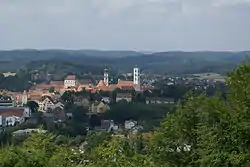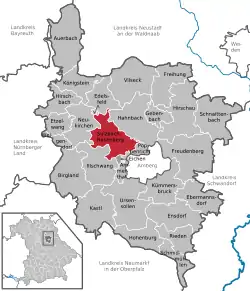Sulzbach-Rosenberg
Sulzbach-Rosenberg is a municipality in the Amberg-Sulzbach district, in Bavaria, Germany. It is situated approximately 14 km northwest of Amberg, and 50 km east of Nuremberg. The town consists of two parts: Sulzbach in the west, and Rosenberg in the east.
Sulzbach-Rosenberg | |
|---|---|
 View of Sulzbach from Annaberg | |
 Coat of arms | |
Location of Sulzbach-Rosenberg within Amberg-Sulzbach district  | |
 Sulzbach-Rosenberg  Sulzbach-Rosenberg | |
| Coordinates: 49°30′N 11°45′E | |
| Country | Germany |
| State | Bavaria |
| Admin. region | Oberpfalz |
| District | Amberg-Sulzbach |
| Government | |
| • Mayor | Michael Göth (SPD) |
| Area | |
| • Total | 53.19 km2 (20.54 sq mi) |
| Highest elevation | 567 m (1,860 ft) |
| Lowest elevation | 388 m (1,273 ft) |
| Population (2019-12-31)[1] | |
| • Total | 19,410 |
| • Density | 360/km2 (950/sq mi) |
| Time zone | UTC+01:00 (CET) |
| • Summer (DST) | UTC+02:00 (CEST) |
| Postal codes | 92237 |
| Dialling codes | 09661 |
| Vehicle registration | AS, BUL, ESB, NAB, SUL |
| Website | www.sulzbach-rosenberg.de |
Archeological evidence tells that Sulzbach was an important centre from the 8th century on. Sulzbach castle was founded during the early 8th century, probably by the late-Merovingian/early-Carolingian kingdom.
The castle was the residence of the powerful counts of the Nordgau (9th–10th century), the important counts of Sulzbach (c. 1003 – 1188) — one of whose daughters, Bertha of Sulzbach became the Empress of Byzantine Emperor Manuel I Comnenus — and later of the counts of Hirschberg (1188–1305), the counts of Wittelsbach (1305–1354, 1373–1504), emperor Karl IV (1354–1373), the palatine-dukes of Neuburg and of the dukes of Palatinate-Sulzbach (17th–18th century) of the House of Wittelsbach.
Districts
| Etzmannshof | Kauerhof | Niederricht | Siebeneichen |
| Forsthof | Kempfenhof | Obersdorf | Stephansricht |
| Gallmünz | Kleinfalz | Prangershof | Stifterslohe |
| Großalbershof | Kropfersricht | Prohof | Sulzbach-Rosenberg |
| Großenfalz | Kummerthal | Rummersricht | Untermainshof |
| Grottenhof | Lindhof | See | Unterschwaig |
| Grund | Lobenhof | Seidersberg |
Notable people
- Gertrude of Sulzbach (* around 1110 in Sulzbach; † 14. April 1146 in Hersfeld), Empress of Germany and second wife of Emperor Konrad III., Sister of Bertha von Sulzbach. The Holy Roman Empire of German Nations elected an Emperor
- Bertha of Sulzbach
- Christian Knorr von Rosenroth, Christian Hebraist and Christian Cabalist
- Charles Diebold, a German-American locksmith and founder of Diebold
References
- "Tabellenblatt "Daten 2", Statistischer Bericht A1200C 202041 Einwohnerzahlen der Gemeinden, Kreise und Regierungsbezirke". Bayerisches Landesamt für Statistik und Datenverarbeitung (in German). July 2020.